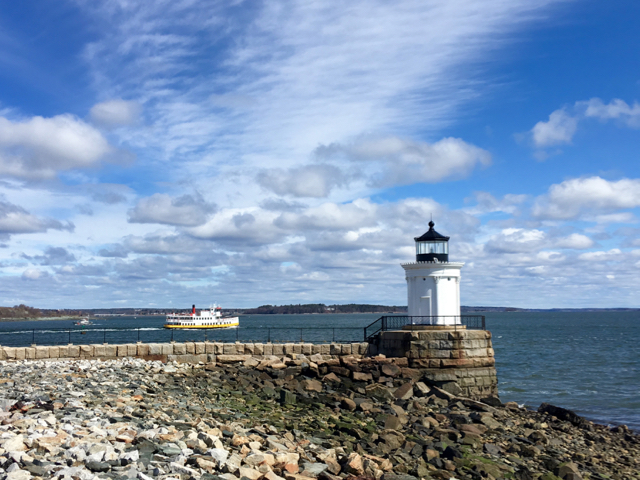
When sunshine and a hint of spring greeted my awakening, I decided to loop out to South Portland for breakfast with a friend. It proved to be a brilliant idea, even if a brisk breeze fought off any illusion of warmth. (Updated March 9, 2024)

First stop: Scratch Bakery
Whenever I’m in the ‘hood, Scratch is on my must-stop list. I have friends from New York who come to this Willard Square shop to purchase bagels, which gives you an idea of the quality. On this trip, I picked up a dozen, along with some English muffins and bread. Somehow I managed to escape without buying a croissant, cookie, or other temptation.

Second stop: Bug Light Park
Sure, Bug Light Park is a great place to walk off breakfast and take in the Portland skyline, but it also offers a few history lessons. In season, May 1-late October, the South Portland Historical Society and Museum is open near the park’s entrance.
The park’s lighthouse is officially known as Portland Breakwater Light, but due to its diminutive size, it earned the nickname Bug Light. You can walk out to and around the rather elegant, cast-iron lighthouse, which was constructed in 1875 and modeled on an ancient Greek monument.
During World War II, New England Shipbuilding Corp. built 236 Liberty Ships on two yards, here. The first ship constructed, the John Davenport, launched in 1941. Honoring that history is the Liberty Ship memorial, a 35-foot-tall by 65-foot-long open replica of a Liberty ship bow. Walk through and read the interpretive signs.
At sunset, the views over Portland’s skyline from Bug Light Park are fabulous.

Third stop: Spring Point
Getting to Spring Point Lighthouse requires walking or driving through the Southern Maine Community College campus. If I had attended college here, I likely would have spent all my time gazing out the windows or beachcombing, rather than studying. We arrived at low tide, perfect timing for combing the beach for sea glass and other treasures.
Spring Point Ledge Lighthouse’s 54-foot-tall brick tower was built on a cast-iron cylindrical caisson in 1897. In the 1930s, it was encircled with granite blocks to protect it from ice damage. The U.S. Army Corps of Engineers built the 900-foot, 50,000-ton breakwater connecting the light to the Fort Preble shoreline in 1951. It is the only caisson-style (or sparkplug) lighthouse accessible by land. In season, you can actually enter the lighthouse for $5.
After admiring the lighthouse from afar (it was too cold and windy to navigate the breakwater without a heavy coat and hat), we prowled around the remnants of Fort Preble, which guarded Portland Harbor from 1808 to 1947.
***
Note: For a nice walk or pedal, you can connect Bug Light to Spring Point Ledge Light and beyond to Willard Beach with the Spring Point Shoreway.














